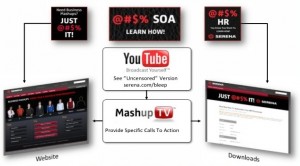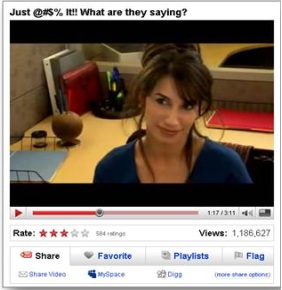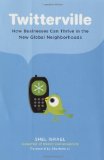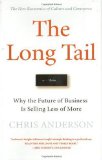#mptech Case Study of Viral B2B Video
 Rene Bonvanie, VP of Worldwide Marketing, Palo Alto Networks, presented on a viral video he created while with Serena Software. The goal of the video was to increase the use of the company’s mashup tools. Instead of creating a “standard” B2B video at the time, the company decided to adopt a more consumer-focused approach of using sex and innuendo. In essence, they were seeking to create a strong emotional response to the video – either you hated or loved it. I’ve embedded the original video below.
Rene Bonvanie, VP of Worldwide Marketing, Palo Alto Networks, presented on a viral video he created while with Serena Software. The goal of the video was to increase the use of the company’s mashup tools. Instead of creating a “standard” B2B video at the time, the company decided to adopt a more consumer-focused approach of using sex and innuendo. In essence, they were seeking to create a strong emotional response to the video – either you hated or loved it. I’ve embedded the original video below.
Starting a Fire
“No long tail in social media. It happens or doesn’t.” – Rene Bonvanie
While the video only cost $5,000 to develop, the challenge was generating the fire to start the buzz. The key considerations for Serena Software were:
* How to increase/enable social networking
* Have users push and syndicate the content rather than pushing it themselves
* Coordinated efforts with traditional media and advertising activities
 The company first created two versions of the video: a censored version for YouTube which linked to an uncensored version on the company’s website. The company then leveraged traditional advertisements on targeted websites that played on the “censored” theme. As the ad campaign continued, media outlets began to pick up on the, at the time, unique campaign.
The company first created two versions of the video: a censored version for YouTube which linked to an uncensored version on the company’s website. The company then leveraged traditional advertisements on targeted websites that played on the “censored” theme. As the ad campaign continued, media outlets began to pick up on the, at the time, unique campaign.
Simultaneously, the company built a video channel related to the original video. As the views increased for the viral video, other videos also saw an increase in views as a halo effect.
Questions from the audience
Note: I tried to capture the questions and quote as fully as I could and is not meant to be a “transcript” of what was said. Questions are in purple with the response italicized.
Insights with global marketplace and how to adapt this? One of the things we found is that from a B2B perspective, the audience speak English for B2B.
What was the magic sauce for the video? Sex and innuendo.
Had you thought of anything else besides sex/innuendo? Did take out some of the sex and tried the office/Seinfeld humor. Thought it was done before and wouldn’t go that well. Looked at consumer brands to see what they did and to combine those elements with office setting did well.
What was the impact on sales for the video? There were two ways to look at that. At the end of the day was to have people evaluate the software. Got $10 million in sales with $40 million in opportunities and 100,000 to conduct trials.
In conclusion, Bonanvie recommended caution when seeking to create such a video. You have to consider the creative, brand, comments from viewers, and related videos.
Other posts regarding MarketingProfs SocialTech 2010:
PRMM Interview – Ken Molay of Webinar Success

Webinars has become an important toll for marketers. I asked Ken Molay, president and founder of Webinar Success, to share his thoughts on the evolution of webinars, how marketers can best leverage this for their programs, and what to expect in a couple of years. Here is Ken’s bio:
Ken Molay is president and founder of Webinar Success, a consulting firm that assists companies in producing and delivering effective and compelling web seminars. Ken combines a technical background with experience in corporate marketing and public presentations. He is a prolific blogger on the subject of web conferencing and its applications, and has been quoted in the Wall Street Journal and industry publications. He is a frequent public speaker on the topic of more effective webinars.
You’ve been writing about webinars for awhile. What is the most significant change that you’ve seen?
I started using webinars as a marketing tool some ten years ago. At that time, the concept was a novelty. I was constantly explaining what they were. Now webinars are ubiquitous and almost every business person has at least attended one, if not presented one. Attendance rates for marketing webinars used to be very high, averaging 50-60% of registrants. Now they average 33%. People will no longer attend just for the experience of trying out a new learning medium. As usage becomes more common, presenters spend less time and effort on preparation. This is rapidly leading to audience dissatisfaction as they attend more and more online sessions where presenters read text off slides, sound disinterested in their own material, and don’t seem to care about delivering value as much as collecting names and emails on the registration form. Companies who host webinars need to “up their game” and concentrate on creating value for their attendees in both content and presentation.
So webinars have become a key tool in a marketer’s toolkit. What are the top three things that marketers need to consider when using webinars for their programs?
a) The webinar title, promotional efforts, and content MUST be framed in terms of audience interests and benefits instead of the host’s informational content. Instead of telling your audience “We wanted to tell you about our latest offering” you need to tell them “Learning about our latest offering will benefit you in the following ways.”
b) Watch out for the “successful webinar” trap. Many marketing departments try a webinar and get good results on gathering leads and seeing a very positive cost-benefit. So the boss says, “Great! Do one of these a week. This is a cheap lead generating machine!” You end up with “list exhaustion” as people don’t want to attend that frequently and you end up with “presenter exhaustion” as there is not enough time to prepare and rehearse compelling content. Your presenters view it as an inconvenient distraction from their “real jobs”. Quality goes down, your audience stops coming, and your boss gets angry.
c) Your success in turning marketing webinar attendees into sales prospects is greatly influenced by your speed of response after the event. Don’t just dump the registration list into a CRM system for eventual follow up by a salesperson. A “follow up” call or email two weeks later has the same psychological impact as a cold call. You need to send follow up email within 24 hours of your webinar. Immediately following the event, have someone go through the webinar chat log or feedback responses, looking for people who asked a specific product question or requested a contact. Get back to them the same day. Have your supporting material or collateral ready to send… Don’t wait until after the webinar to assemble it.
The space has become more crowded with more vendors and offerings. Where do you see the industry going in 1-2 years?
Video is the hot item of the year. Vendors are rapidly adding what they refer to as “high def” streaming video capabilities to their webinar products. I am comfortable with presenter video in smaller team meeting applications, but I am not a fan of live video for public marketing webinars. It puts a tremendous additional burden on the presenter, who cannot easily move around, look at notes, or check the web conferencing console without breaking eye contact with the audience. It is harder to create a professional corporate image with video because of the many subtle visual cues we respond to as viewers without consciously realizing it. Video also demands much more bandwidth, and companies run the risk of excluding or delivering subpar experiences for attendees with slower network connections. So I think we may see a wider adoption of video conferencing initially, followed by a pullback (at least for marketing webinars) while companies wait for infrastructure to catch up and for their production teams to learn a new set of best practices.
The other trend I see developing is a desire for easier monetization of webinars. This does not directly affect marketing webinars, but many companies want to deliver fee-based training, consultation, and support to a wider audience than they can reach with in-room seminars. There are not enough technology choices and integrated features in the market to make this easy and cost-effective to implement.
Have you leveraged webinars for your program? If so, share your successes, lessons learned and more below.
PRMM Interview: Jason Falls Discusses Social Media and Communications
A couple of weeks ago, I met up with Jason Falls of Doe Anderson and Social Media Explorer. After a beautiful meal at Il Fornaio with Jason and his wife, we sat down for a quick video about social media and communciations strategies. Here is a summaryof this video.
Communications Strategy: Traditional and Social Media
* Communications strategies for traditional PR is typically one that looks at talking points and messages we want to communicate via traditional media
* Traditional media is about one-way communciations with the audience
* With social media, traditional media is no longer part of this as now you’re going direct to the consumer
* No longer is it one-way communications. It’s about how you can create a strategy to communicate these talking points in a conversational way
Different for B2B and B2C?
- Not necessarily as B2B is in between the two extremes of traditional media and social media
- Regardless if this is B2B or B2C, social media requires a conversation
- How can you be nimble in your conversations
Tweet this on Twitter
PRMM Interview with Jason Falls regarding social media and communications strategy by @csalomonlee: http://twurl.nl/a70p7g
Three Tips for Your YouTube Video
Over the past few weeks, I’ve been experimenting more with video. It’s visual and can communicate a lot in a short span of time. I want to share three tips that I’ve learned over the past few weeks for your http://www.YouTube.com/ videos.
The Quality Vs. Content Dilemma
There are two camps on the quality of the video versus the content. Some insist that the video be high-production quality while others (like me) believe that slighter lower quality with good content is fine. I prefer the latter because I’ve seen videos held up because of delays with production. By the time the video is “production quality,” you may have missed an opportunity to lead with quality content.
I argue that as long as you have quality content, your viewers are willing to sacrifice a little quality.
Engaging Spokesperson
When doing a video, the spokesperson is just as important as the content. You may have the best content but if the person is unable to deliver it convincingly and in an engaging way, people may stop the video and go elsewhere.
Distributing the Video
The last part is how to distribute your video. I’ve personally defaulted to YouTube and I believe that YouTube is becoming a place for business videos too. For those who may not want to watch the video, consider writing an accompanying post that summarizes the key points. Instead of a social media press release, I recommend issuing a press release that points to a page that has the video on your website alongside with other relevant content.
Conclusions
Since starting my new job, I haven’t had much time to devote to my blog. To me, video may be a way for me to capture my thoughts and introduce you to folks in the industry as well. Let’s see how this works. What do you think? Do you like the videos or prefer my written posts?
Side Note – Flip mini HD
So I just bought the Flip mini HD to post higher quality video while not breaking the bank. I like the little camera, but I thought I had uploaded a HD quality video. Because the Flip software doesn’t have many editing options,I imported the video to the Windows Movie Maker program that came with my computer. The video played well on my computer but I lost something as it was uploaded. I think I may take a page from my friend John Welsh, who just records and posts the whole video without any editing.
PRMeetsMarketing Weekly Articles: December 6
Here is this week’s of interesting articles. You can click on the Weekly Articles tag for previous issues or subscribe to the Weekly Articles Feed:
Online Video Kill the TV Star –Blip.TV interviews Vivian Schiller, general manager of the NYTimes.com about the differences between online and TV video. To paraphrase that iconic song, “will online video kill the TV star?”
Or Did ROI Kill Marketing? – Paul Dunay of Buzz Marketing for Tech makes a good point about ROI. His point is, if everything is measured against an ROI, then there are probably some campaigns/initiatives that wouldn’t be done because it wasn’t measurable.
Does the Long Tail Work for PR? – Now Is Gone does a great job at highlighting the Long Tail for PR. I’m in the middle of reading the book so this posting will help me to position PR/marketing as I read through the book. Also included as part of my 2008 trends piece.
WPP Lands a Big Whale – Dell selected WPP to create an integrated marketing agency that will serve Dell’s business over the next three years. It’ll be interesting to see how WPP organizes this new entity before March 2008. Will key individuals throughout the WPP group be hand picked to lead the charge? Will smaller (less profitable?) agencies be merged together to create this new agency with instant staff? Or will WPP create an entirely new entity and poach talent from the competition? Only time will tell.
Social Media Reaches Into Your Lives – I’ve started reading the Lonely Marketer, which provides ideas for small business marketers. In this post, he writes about how social media can be used to find target customers, thereby increasing touchpoints for increased engagement/participation.
Video’s Political Influence? – Granite Slate posted an article about how KD Paine & Partners is measuring the impact of online videos on a candidate’s influence and surge in the media. This is an interesting concept and would love to see how accurate this is as the caucuses approach. I could envision this having a larger impact on younger people who normally may not go to the polls to take action and participate. And isn’t that what it’s all about in the end??
Bribes Aren’t Conversation Starters – Mike Volpe of Small Business Hub highlights how Vocus tried to follow up on a “sales lead” from a white paper download. Love the cookie idea, but no connection to the value that Vocus provides to Mike’s company. As Mike pointed out, you need to start a conversation with the person which can be started via phone follow up or email with links to valuable information. Provide value, not tchokes.
Note to NYT – Keep up with the times… – Read Kate Swisher’s post on BoomTown about a recent speech by Bill Keller of the New York Times. Keller bashes on bloggers and the quality of reporting. Does this mean I should stop reading the Bits blog? The issue isn’t about quality of reporting but how blogging augments the information flow out there. You can’t tell me that all “traditional” media have excellent standards. Keep up with the times Mr. Keller.
technorati tags: Blip.tv bloggers Buzz Marketing for Technology Dell KD Paine Long Tail Lonely Marketer Marketing Measurement Now Is Gone PR Small Business Hub social media video WPP
del.icio.us tags: Blip.tv bloggers Buzz Marketing for Technology Dell KD Paine Long Tail Lonely Marketer Marketing Measurement Now Is Gone PR Small Business Hub social media video WPP
icerocket tags: Blip.tv bloggers Buzz Marketing for Technology Dell KD Paine Long Tail Lonely Marketer Marketing Measurement Now Is Gone PR Small Business Hub social media video WPP
About
Favorite Service
Recent Comments
- on Going Virtual Isn’t Necessarily the Answer to Replacing Your Physical Events
- on Going Virtual Isn’t Necessarily the Answer to Replacing Your Physical Events
- on Going Virtual Isn’t Necessarily the Answer to Replacing Your Physical Events
- on Going Virtual Isn’t Necessarily the Answer to Replacing Your Physical Events
- on Going Virtual Isn’t Necessarily the Answer to Replacing Your Physical Events
Ads by Google
Favorite Books
Marketing Blogs
PR Blogs
- KD Paine's Measurement Blog
- Micro Persuasion
Virtual Events & Meetings Blogs
- Cisco Virtual Environments
- It's All Virtual
- The Webinar Blog
- Virtual Edge Institute

 Follow
Follow Cece Salomon-Lee is director of product marketing for Lanyon Solutions, Inc. and author of PR Meets Marketing, which explores the intersection of public relations, marketing, and social media.
Cece Salomon-Lee is director of product marketing for Lanyon Solutions, Inc. and author of PR Meets Marketing, which explores the intersection of public relations, marketing, and social media. 


